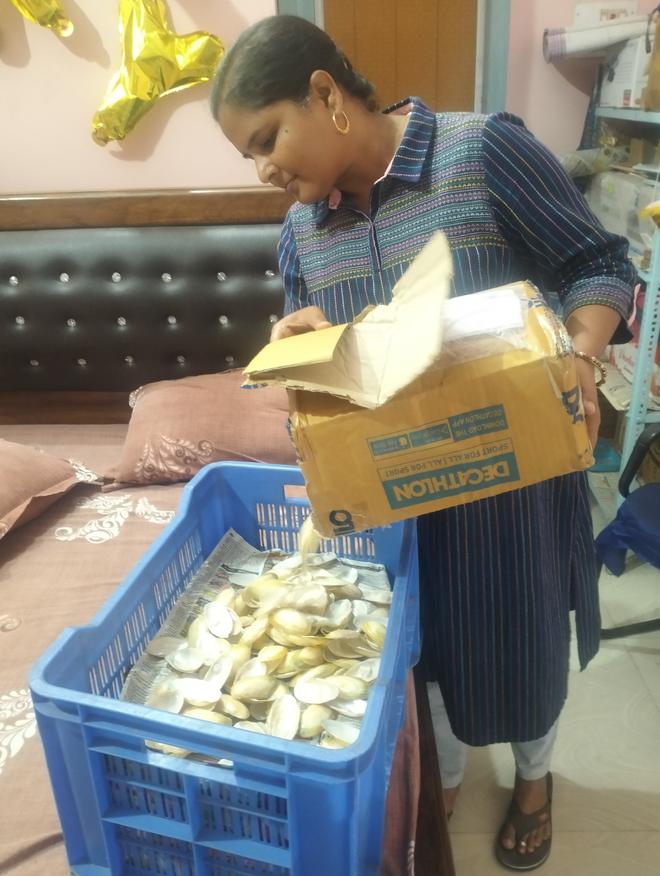With 76% of its population engaged in agriculture, principally in growing food crops (paddy, wheat, maize and pulses), with a small percentage of farmers are engaged in raising cash crops, including sugarcane, potato, tobacco, oilseeds, onion, chillies, and jute, farming is the main source of employment and wealth in Bihar. In the past few years, however, some farmers have been switching to more remunerative alternatives. Pearl farming is one such emerging enterprise, with the potential to deliver superior annual earnings.
There are only about 25 pearl farmers across Bihar currently. In the Nalanda district, most pearl farmers are male. Madhu Patel, a mother of two in her mid-forties, is a lone exception. Ms. Patel’s willingness to adopt modern agri-tech practices has heralded transformative change in her life.
“The first time I heard about pearl farming was in 2016 while watching a show on TV. I enquired a lot about this at the Agriculture Department but nobody had any knowledge about it. They told me that there was no scheme for pearl farming offered by the department. Then, in 2017, I went to CIFA (Central Institute of Freshwater Aquaculture) in Bhubaneswar and undertook training in pearl farming,” Ms. Patel, who holds an M.Sc. from Nalanda College, recalled.
Her first attempt at farming pearls left her with a big loss as the mortality rate was quite high — only 10% of oysters survived and the rest died.
“I did not lose hope and thought that if 10% [of oysters] are alive, pearl farming can be done in Bihar also. I contacted CIFA once again and briefed them about my first attempt, and they gave me some tips. I also realised the mistakes I had made. Then, when I tried again in 2018, the mortality rate was 20% — 80% of the oysters survived! After this, I never looked back, and now, I earn ₹12 lakh to ₹15 lakh every year from pearl farming,” Ms. Patel said.

Ms. Patel farms her pearls in a 27,2220 sq. ft. pond (the approximate equivalent of 1 bigha of land). It takes about 12-18 months to harvest pearls — the more time it takes, the better the results, she said. It takes at least four-five years to create round-shaped pearls.
Each oyster, which contains two pearls, costs ₹6 to ₹10 apiece, and she purchases them in Nalanda itself. For her current harvest, Ms. Patel has planted 5,500 oysters. Depending on its design, each harvested pearl may fetch between ₹150 to ₹300. As she’s unable to secure a good price for them in Bihar, Ms. Patel sells her pearls to a steady set of buyers in Hyderabad, Surat, Mumbai and Delhi.
Nitil Bhardwaj, who has been farming pearls in Bagha in the West Champaran district since 2019, has been able to achieve an annual turnover of ₹40 lakh.
“I was working in a private company where my monthly income was ₹30,000. During a holiday, when I returned to my native place in Ramnagar, my father told me about pearl farming and I liked the concept. I enquired and found out that in Hoshangabad in Madhya Pradesh, training for pearl farming is provided by a private institute. I went there to learn it. In 2019, when I started, I spent ₹25,000 and earned a profit of ₹75,000. Then I decided to continue with pearl farming. Now, I am pearl farming in a one-acre pond with 25,000 to 30,000 oysters,” Mr. Bhardwaj said.
Pearl farming is a laborious process. Oysters are tied in a net and left in the pond for 10-15 days, letting them “create their environment”. Subsequently, they are taken out for “surgery”, which is the process of inserting a mould or particle inside each oyster. The mould develops a coating and then a shell layer, which later becomes a pearl. Following the “surgery”, the oysters are medically treated, sealed in small boxes, and hung in the pond by ropes. Checks have to be run from time to time to remove dead oysters.
Mr. Bhardwaj, who has also started offering training for pearl farming, observed that if the government provided subsidies, more people could adopt pearl farming, which could then develop as a separate sector in farming and play an important role in preventing the migration of labour from Bihar. He said that the State government was supporting fish farming on about 4,000 acres of land, and if pearl farming could be developed in 100 acres of land, it could provide employment to around 12 lakh people.
Also in West Champaran, Shiv Anand Shah of Narkatiyaganj farms pearls and earns about ₹7 lakh to ₹8 lakh annually. “I trained at Banaras Hindu University (BHU) and now do pearl farming with 4,000 oysters in a freshwater pond. I also motivate others to take up pearl farming, which can bring good income when compared with traditional farming,“ Mr. Shah said.
In another success story, Jai Shankar Kumar, a government employee turned pearl farmer in Begusarai district, was lauded by Prime Minister Narendra Modi in the 14th episode of the ‘Mann Ki Baat’ radio programme.
Pearl farmers expressed concern over securing the right price for their harvest, which they presently sell to buyers in other States, including Telangana, Maharashtra, Gujarat and Delhi, adding that good marketing would help them achieve greater success. Meanwhile, Bihar’s intrepid pearl farmers remain motivated by higher reward for less risk from natural disasters than seen in more traditional avenues of farming.







